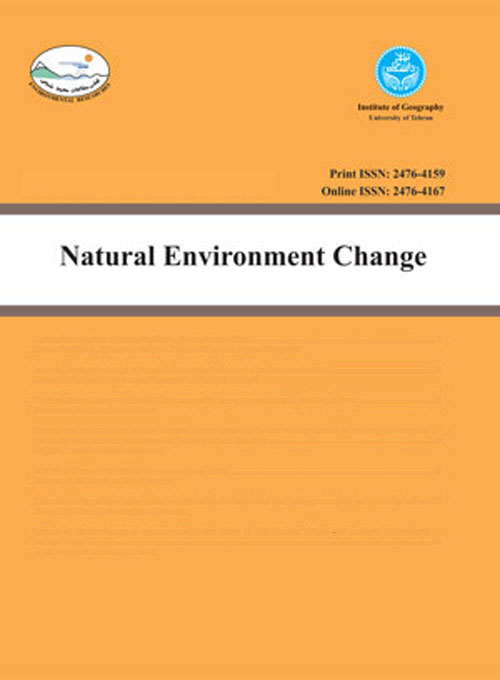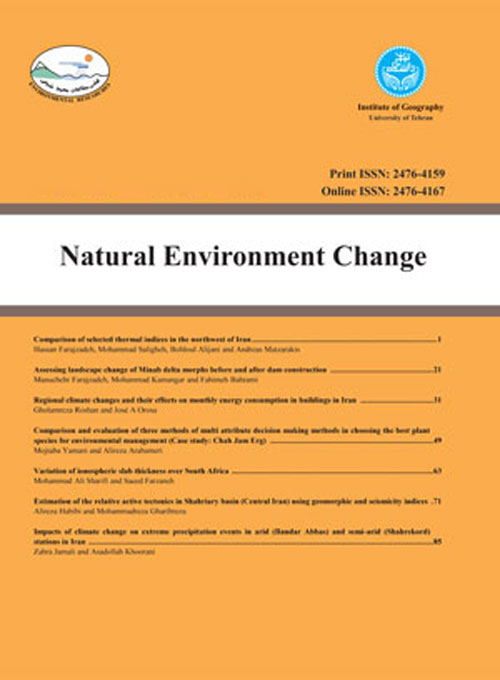فهرست مطالب

Natural Environment Change
Volume:2 Issue: 1, Winter - Spring 2016
- تاریخ انتشار: 1395/06/25
- تعداد عناوین: 7
-
Pages 1-24Soil is one of the most important natural resources covering a large area of the land surface. Soil plays a vital role in biosphere processes, such as energy balance, hydrology, biochemistry, and biological productivity. It supports plants that supply foods, fibers, drugs, and some other human needs. Conversely, desert regions include about one third of earth lands and these regions have increased caused by desertification, which is one of the main three world challenges in 21st century in global scale. Thus, it is important to monitor and map soils (especially in desert regions) and understand how these resources should be utilized, managed, and conserved properly to aim at implementing ecological role. Remote sensing has improved from traditional methods for assessing soils to informative and professional rapid assessment techniques to monitor and map soils. Previous studies have shown the utility of digital aircraft and satellite remote sensor data in the pedologic and geologic mapping process. Remote sensing offers a potential to provide information about soil characteristics over large regions. However, the intent of this paper is to focus on discussion about remote sensing applications to study desert regions. In this review, at first, we would discuss about the remote sensing applications to research on soil properties including soil salinization, crusting, moisture, texture, mineralogy, approaches, and techniques used to classify soils. In second section, we would argue about constraints tied on remote sensing applications data gathering usually conducted about investigation on soil characteristics in arid and semi-arid regions.Keywords: desert areas, remote sensing, soil evaluation
-
Pages 25-33The purpose of this research is to analyze heat waves characteristics in the warm period of the year as a climatic hazard in Iran. In this study, the daily maximum temperature is taken at 44 synoptic stations during the period 1981-2010. These temperature values were used to extract the intensity, frequency and duration of heat waves using percentile thresholds of 90, 95, and 98. The results showed that the average heat waves intensity is added between 3 to 4°C during summer more than spring. During spring and summer seasons, the most intense of heat waves is occurred on the southern coasts of Iran, and the most frequency of heat waves is occurred in the Zagros Mountains and eastern scattered mountainous of Iran. On average, the heat waves frequency is increased about 4 more heat waves during summer than spring. Furthermore, the seasonal average of the most duration of heat waves about 10 to 16 consecutive days has occurred in the southeastern of Iran. Generally, in the higher percentile thresholds heat waves frequency is reduced, but the intensity and duration are increased.Keywords: climatic hazard, heat wave, Iran, percentile thresholds, warm period
-
Pages 35-46Iran is located in an area with high earthquake risk. There are over 20 active faults with length of 500 km and also densely populated parts of the country have been rendered vulnerable to strong earthquakes. However, existence of eight faults of the main faults of Iran along with at least 18 faults with length of more than 100 km in Kerman province have turned the place into one of the riskiest areas of the country. For this reason, this research tries spatial distribution of absorbing centers in Kerman population compared to the high risk of seismic zones of the city. The results show that the total population of absorbing centers in Kerman is 22.2% of the training centers, 34.5% of health care centers, 22.2% of administrative centers, 14% of business centers, and 18.9 % of sports centers which are located across the threat of severe and very severe degradation. In other words, among 973 absorbing centers of population, 190 centers in Kerman are located in zones with high and very high damage and 206 centers are in areas with moderate damage; this means that among total centers of absorbing centers, 396 centers are located in zones with moderate to high risks. The importance of these centers, as well as aggregation of population in these centers, in urban spatial structure and prediction of approaches such as resisting, retrofitting of public education and crisis management is in reducing losses in the event of a seismic event that seems very likely.Keywords: faults, Iran, Kerman, population centers, seismicity
-
Pages 47-55Climate change disturbs the distribution of precipitation patterns and affects water resources. A lot of evidences imply that the increased atmospheric concentration of greenhouse gasses in turn increases the precipitation changes around the world. Thus, since Iran is located in an arid zone of the earth, identifying the effects of CO2 concentrations on Iran precipitation rate is highly important in planning the projects for water resources. Statistical data from 31 selected synoptic stations between 1975-2010 have been used. Also data for CO2 (ppm) were taken from the website of NOAA and then were analyzed by Pearson Correlation Coefficient (PCC). Our results indicate that CO2 had a positive (incaresing) effect on the spring precipitation in the northern areas of Iran and a negative (decreasing) effect in the southern parts of the country. There is not a specific pattern for the distribution of precipitation in the summer; the related data were not much reliable. In the fall, CO2 had an increasing effect on the precipitation rate in the eastern parts and, conversly, a decreasing effect observed in the northern parts (particularly in the southwestern coast lines of the Caspian Sea). Finally, in the winter, precipitation rate showed an increasing pattern and, in some western and northeastern parts of the country, a decreasing pattern was observed.Keywords: CO2, global warming, greenhouse gass, Iran, precipitation
-
Pages 57-66The interaction between sea and atmosphere has profound effects on the regions climate. Meanwhile, the sea surface temperature is considered as one of the most effective components of water bodies, and the controller of many atmospheric behaviors. Because of the importance of sea surface temperatures effects on atmospheric elements and also given the role of global warming on land and sea surface temperature rise, in this study, using water temperature data from AHVRR sensor of NOAA weather satellite, the climatic data bank was prepared for 718 sites across the Caspian Sea for a period of 30 years. Then, the trend of sea surface temperature change was studied for four points in Caspian Sea. The results showed that the temperature has changed because of the short-term climate fluctuations type and has a trend that can be seen in some monthly and yearly series. It was concluded from studying the behavior of U and U' components changes related to the average temperatures of four points on an annual basis, a significant mutation with a positive trend was seen and confluence point of the two sequences from 1995 to 2000 is considered as the change point. In conclusion of studying the trend of Caspian SST, it can be said that some parts of this sea is going through the trend of temperature rise and partial warming, that it is consistent with the results of many studies in which the findings are consistent with warming and changes in sea surface temperatures of aqueous areas.Keywords: Caspian Sea, Climate change, sea surface temperature, unsustainable Mann, Kendall test
-
Pages 67-77Drought is one of the natural phenomena which occurs in all climates in different parts of the world. Iran is located in the dry belt of the world. The increase of desertification, drought reoccurrence, and destruction by human in this geographical region needs more studies on spatial and temporal trend of rainfall. In this study, trends of climatic drought during 1975-76/ 2004-05 in seasonal and yearly time scales were evaluated at 50 synoptic stations in Iran using a drought index, RDI (Reconnaissance Drought Index), and Mann-Kendall non-parametric test, at 90 and 95% confidence levels. Results showed that among studied stations, in which RDI was calculated for, 89% had an ascending trend, and results of Mann-Kendall non-parametric test on annual values of RDI showed that among 21 stations, 76% of them had a negative trend and 24% had a significant positive trend. Based on results of this study, there exists an increasing drought trend at all-time scales in Iran.Keywords: climatic drought, drought trend, Iran, Mann–Kendall test, RDI
-
Pages 79-87Management of natural ecosystems, like forests, has several objectives such as wood production, sustainability of ecological systems, preserving aestheti,c and cultural or psychological satisfaction. This management is especially essential in dry regions with sensitive biodiversity, like Iran. The aim of this research is to elaborate a management scheme for developing a sustainable tourism plan for the Kiyan Forest Reserve, using an Analytical Hierarchy Process. At this point, four management alternatives were evaluated from socioeconomic, management (monitoring by governmental or private sector), environment and recreational perspectives. Each part was given a weight based on the opinions of specialists and local experts and tourist (by means of Questionnaire) using the "Expert Choice 11" Software. The results showed that the importance of these criteria is descending in the following order: socioeconomic, management (monitoring), environment, and finally promotion of the regional conservation and biological actions. Also, contribution of each part to the management plan was 47.8% for the environment and 46.2% for the promoting plan of the regional management. In this study, environment criterion is selected as the most important criterion and upgrading region protection is introduced as the best plan. Consideration towards the application of Analytical Hierarchy Process in tourism sustainable development and based on the former findings concludes that protection level in this area must be upgraded to national natural zone.Keywords: AHP, ecotourism, Kiyan forest reserve, management plan, sustainable development


